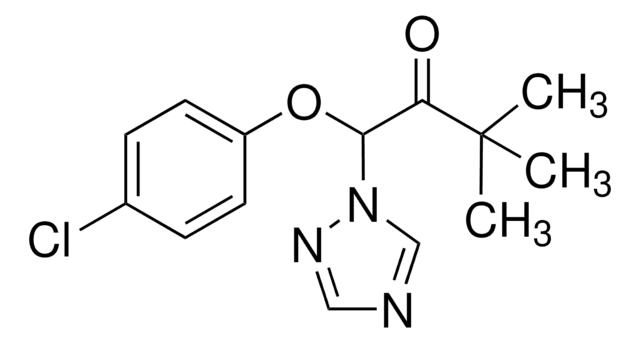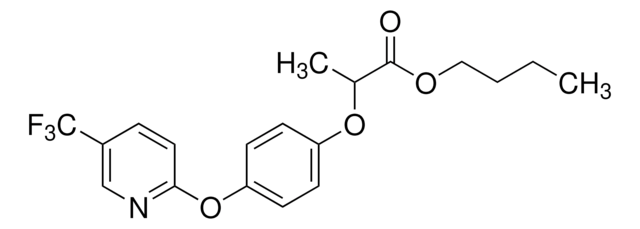CRM05394
Fenazaquin
certified reference material, TraceCERT®, Manufactured by: Sigma-Aldrich Production GmbH, Switzerland
About This Item
Produits recommandés
Qualité
certified reference material
TraceCERT®
Niveau de qualité
Gamme de produits
TraceCERT®
Forme
solid
Durée de conservation
limited shelf life, expiry date on the label
Fabricant/nom de marque
Manufactured by: Sigma-Aldrich Production GmbH, Switzerland
Température de stockage
2-8°C
Chaîne SMILES
CC(C)(C)c1ccc(CCOc2ncnc3ccccc23)cc1
InChI
1S/C20H22N2O/c1-20(2,3)16-10-8-15(9-11-16)12-13-23-19-17-6-4-5-7-18(17)21-14-22-19/h4-11,14H,12-13H2,1-3H3
Clé InChI
DMYHGDXADUDKCQ-UHFFFAOYSA-N
Vous recherchez des produits similaires ? Visite Guide de comparaison des produits
Catégories apparentées
Description générale
Certified content by quantitative NMR incl. uncertainty and expiry date are given on the certificate.
Download your certificate at: http://www.sigma-aldrich.com
Fenazaquin is an insecticide/acaricide that belongs to the class of quinazoline compounds. It shows ovicidal activity against phytophagus mites found in agricultural crops of almonds, citrus fruits, and grapes. It is highly lipophilic and inhibits site I of the electron transport chain in mitochondria. Its acceptable daily intake (ADI) according to body weight is 0.005 mg/kg.
Fenazaquin was approved for use in the European Union on 1st June 2011 following a request for its inclusion according to Reg. 33/2008 and its approval for use expires on 31st May 2023. The maximum residue limit (MRL) for fenazaquin in citrus fruits is 0.5 mg/kg and 0.2 mg/kg in tree nuts. Fenazaquin is to be monitored in the Multiannual Control Programme for Pesticides Residues (MACP), run within the EU and EFTA in/on products of plant origin.
Application
It may also find following uses:
- Determination of trace levels of fenazaquin in raw almond samples using dispersive magnetic solid phase extraction (DMSPE) and gas chromatography-mass spectrometry (GC-MS)
- Development of a liquid phase microextraction method using eutectic solvents for extraction from different fruit and vegetable samples and gas chromatography determination
- Switchable solvent microextraction of pesticide residues from food and environmental samples
- Evaluation of 60 pesticide residues in 144 different fruit and vegetable samples by LC-MS/MS method
- Study of matrix effects in pesticide residue analysis in different citrus fruits using ethyl acetate for extraction and Ultrahigh-Performance Liquid Chromatography–High-Resolution Mass Spectrometry for determination
- Residue analysis of 64 pesticides from various groups by nanoflow liquid chromatography-mass spectrometry (LC-MS)
Produits recommandés
Informations légales
Mention d'avertissement
Danger
Mentions de danger
Conseils de prudence
Classification des risques
Acute Tox. 3 Oral - Acute Tox. 4 Inhalation - Aquatic Acute 1 - Aquatic Chronic 1
Code de la classe de stockage
6.1C - Combustible acute toxic Cat.3 / toxic compounds or compounds which causing chronic effects
Classe de danger pour l'eau (WGK)
WGK 3
Point d'éclair (°F)
Not applicable
Point d'éclair (°C)
Not applicable
Choose from one of the most recent versions:
Certificats d'analyse (COA)
Don't see the Right Version?
If you require a particular version, you can look up a specific certificate by the Lot or Batch number.
Déjà en possession de ce produit ?
Retrouvez la documentation relative aux produits que vous avez récemment achetés dans la Bibliothèque de documents.
Notre équipe de scientifiques dispose d'une expérience dans tous les secteurs de la recherche, notamment en sciences de la vie, science des matériaux, synthèse chimique, chromatographie, analyse et dans de nombreux autres domaines..
Contacter notre Service technique










